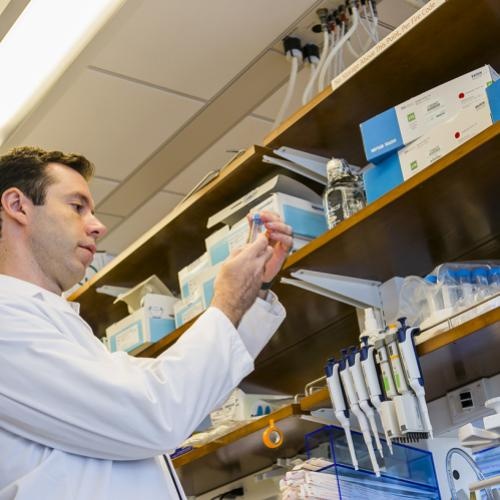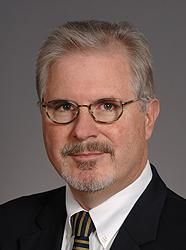New study describes genomic landscape of castration-resistant prostate cancer
An international collaboration of researchers are advancing precision medicine to men with a common and aggressive form of prostate cancer.
Several scientists from the Edward and Sandra Meyer Cancer Center were part of a Stand Up to Cancer-Prostate Cancer Foundation Dream Team that sequenced the DNA and RNA of tumor biopsy samples from 150 men with metastatic castration resistant prostate cancer, an advanced cancer that has stopped responding to standard hormone-based therapies.
Previous studies have looked at the genomic landscape of clinically localized prostate cancer and found few actionable genomic alterations. This study – published May 21 in Cell -- is the first to focus on this specific subtype clinically, which is difficult to treat because patients nearly always develop resistance to currently available treatments.
“One of the surprising findings in this study was that approximately 90 percent of cases harbored some kind of genetic anomaly that was clinically actionable, meaning we have potential treatments to target that specific aberration. This suggests that clinical genomic sequencing could impact treatment decisions in a significant number of patients with disease,” said Arul Chinnaiyan, M.D., Ph.D., director of the Michigan Center for Translational Pathology and S.P. Hicks Professor of Pathology at the University of Michigan Health System, one of six co-senior authors of the paper.
A clinical trial for men with advanced neuroendocrine prostate cancer led by Himisha Beltran, M.D., assistant professor of medicine, was part of the study, and Juan Miguel Mosquera, M.D., and Brian Robinson, M.D., assistant professors in the Department of Pathology and Laboratory Medicine at Weill Cornell Medical College, provided expert pathology review.
The Weill Cornell team also played a key role in bioinformatics for the study. Drawing on the experience of Weill’s Institute for Precision Medicine (IPM), the faculty collaborated with colleagues at the Broad Institute and Memorial Sloan Kettering Cancer Center to develop bioinformatics approaches that could be implemented across the eight institutions participating on the Stand Up to Cancer (SU2C) team – a proof of principal that could prove valuable when designing precision medicine initiatives on a national and international scale, as recently proposed by President Barack Obama and others.
“The success of this SU2C/PCF trial is a great demonstration that precision medicine can work in a multi-institutional setting to help advance our understanding of cancer and lead to new treatments,” said IPM director Mark A. Rubin, M.D., the Homer T. Hirst III Professor of Oncology in Pathology who was also a co-senior author on the Cell study.
Other Weill co-authors include: David Nanus, M.D.; Scott Tagawa, M.D.; Olivier Elemento, Ph.D.; Andrea Sboner, Ph.D.; Francesca Demichelis, Ph.D.; Marc Schiffman, M.D.; Alex Sigaras, M.S., MBA; and Kenneth Eng, M.S.
One of the unique aspects of the SU2C study is that it used fresh biopsy samples from living patients with metastatic castration resistant prostate cancer. Typically it has been difficult to obtain a large enough quantity of quality tumor tissue, especially from bone biopsies, to make sequencing possible.
“Up to now, precision cancer medicine activities in advanced prostate cancer have been limited by lack of ability to acquire clinical samples from patients at the time of failure of hormone treatment and a lack of comprehensive genomic data for potentially actionable alterations,” said Charles L. Sawyers, M.D., chair of the Human Oncology and Pathogenesis Program at Memorial Sloan Kettering Cancer Center, who was another co-senior author. “This multi-institutional and international study demonstrates the feasibility of comprehensive and integrative genomics on prospective biopsies from individual patients to enable precision cancer medicine activities in this large patient population.”
The researchers found that nearly all the tumors had a genetic aberration known to drive cancers. The most common, found in nearly two-thirds of the patients, were aberrations in the androgen receptor. This was expected to some extent since the hallmark of castration-resistant disease is that it no longer responds to conventional androgen-blocking therapies. But many other aberrations were found as well.
Fourteen percent of patients had a mutation in the BRCA1 or BRCA2 gene, which are already known to increase risk of breast and ovarian cancer. A class of drugs called PARP inhibitors have already been approved in BRCA-positive ovarian cancer, suggesting potential for PARP inhibitors to play a role in prostate cancers with this type of aberration.
In addition, the researchers found that 8 percent of patients had an inherited genetic alteration. This suggests that genetic counseling may be appropriate for patients with prostate cancer.
As part of their Stand Up to Cancer-Prostate Cancer Foundation grant, the researchers will sequence and follow a total of at least 500 patients. They expect the process to take several more years. As they begin to see more patients with androgen receptor mutations and other aberrations, the researchers hope to begin linking specific aberrations to response or resistance to specific treatments, making precision medicine more relevant and successful for metastatic castration resistant prostate cancer.
Additional authors are from the University of Michigan, Dana-Farber Cancer Institute, the Broad Institute, the Fred Hutchinson Cancer Center, the University of Washington, the Institute of Cancer Research in London, the Royal Marsden NHS Foundation Trust in London, Beth Israel Deaconess Cancer Center, Brigham and Women’s Hospital, University of Trento, Italy, Wayne State University School of Medicine, Barbara Ann Karmanos Cancer Institute, Johns Hopkins School of Medicine.
Additional funding came from: the National Institutes of Health; the U.S. Department of Defense; Starr Cancer Consortium, A. Alfred Taubman Institute; American Cancer Society; Damon Runyon Cancer Research Foundation; Prostate Cancer Foundation; Movember Foundation; Prostate Cancer UK; Cancer Research UK; and Department of Health in the UK.









